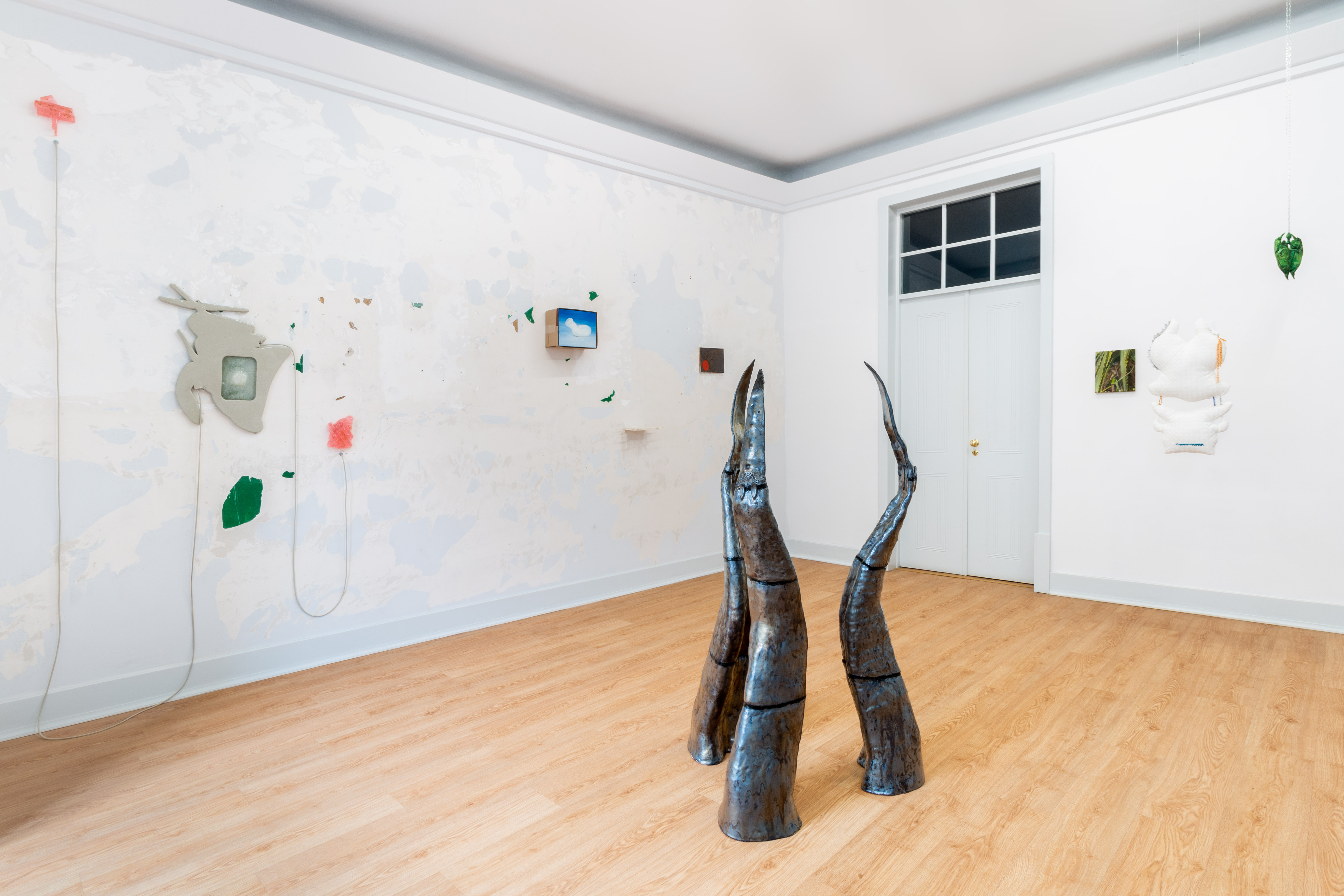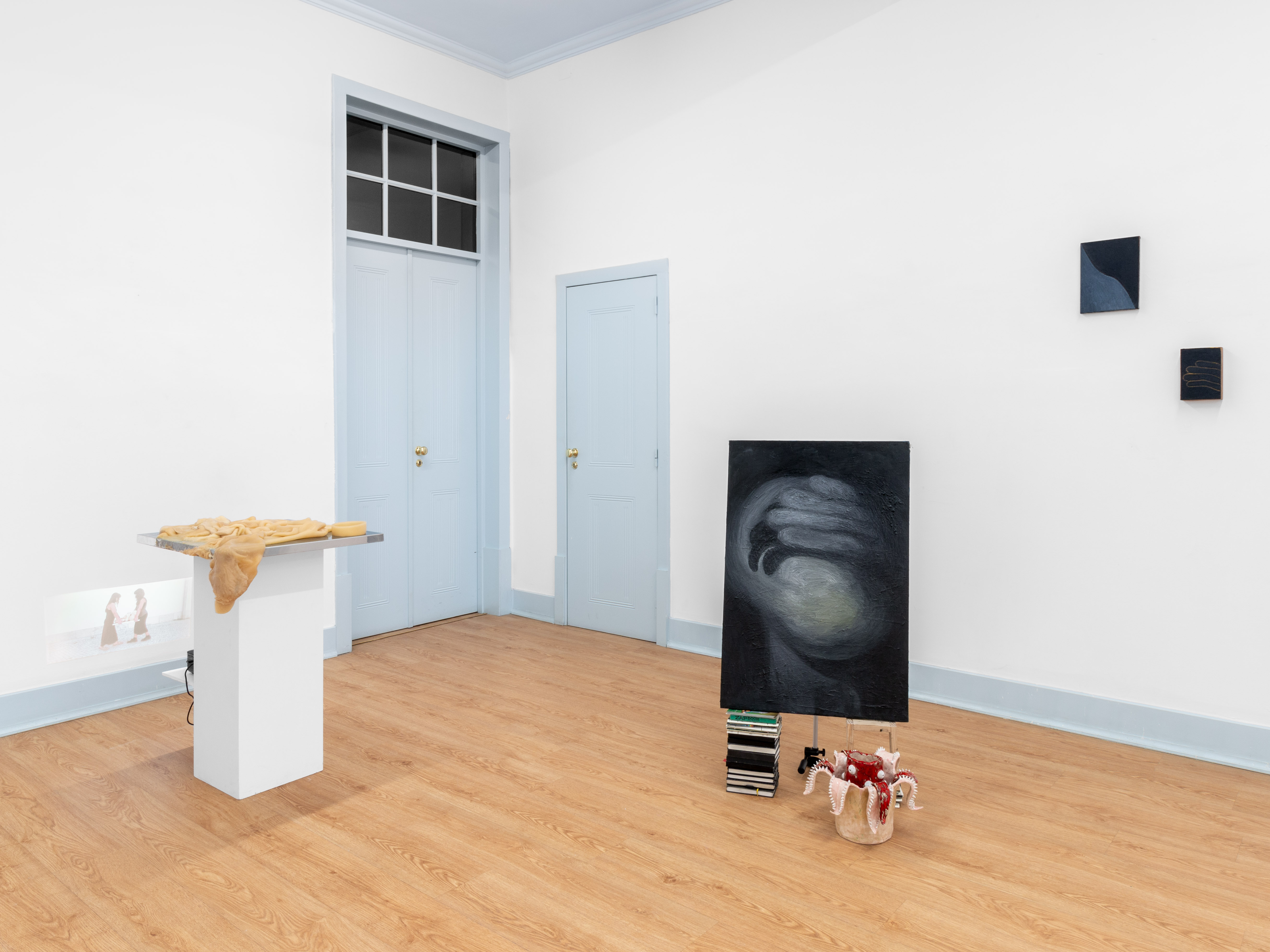Caring is Sharing (2022) | Curated show











Curated show presented at Cabanamad. This project is the first show curated by Francisco Trêpa, with Beatriz Coelho, Carlota Bóia Neto, Eva Gaspar, Gabriel Ribeiro, Maria Máximo, Matias Romano Aleman, Pedro Barassi and Pedro Moreira.
The premise of this exhibition starts with the ideas of sharing and contagion from individual artistic expression to a sense of collectiveness. Caring is Sharing intends to reflect on the term “collective exhibition” as a motto, underpinning the artistic production presented in this exhibition. Artistic practices, despite being often individual, were never constructed alone. References, inputs, collaboration, feedback, exchange, camaraderie, artistic and intellectual companies, are and have always been integral to the act of art-making. The creation process is permeable to and permeated by the outside world, thus forming, in process and in practice, an interior>exterior>interior micro-macro-cosmos. In this exhibition, each artist will be challenged to permeate and activate
the work of another artist. Starting from the logic of drawing lots, allowing chance to dictate which work each artist will react to. The idea is that the activation of one work results in another work. The process should be carried out with mutual freedom and respect.
Caring is Sharing at Cabanamad - Umbigo magazine https://umbigomagazine.com/en/blog/2022/10/24/caring-is-sharing-na-cabanamad/
It has been difficult to understand some issues in contemporary art since the middle of the last century. According to Arthur Danto, current artistic currents are based on a practice increasingly dependent on the market flow and fluctuating actions – legitimised by critics, curators, gallerists and dealers who constitute the “art world”. The discourse of many artists is sabotaged by the inherent and obvious need to survive as full time workers while creating something with critical substance.
Apart from the obvious creative burnout suffered by some due to being forced to pander to dominant and profitable tastes[1], this scenario often exerts an extreme loneliness on artists’ daily work. They try to squeeze, like a dried orange once juicy, the last drops of genius of the “original”.
We must say that the fallacy of the artist plagued by the contemporary market is valued. However, more importantly, we must recognise that without artists’ contact with each other, what we now understand as art would not exist in its current form.
According to Bourriard in his relational aesthetics, art is contact[2]. This statement is the embryo of this article, made by four hands, metaphorizing the constant exchange as if it were a ping-pong match. The group exhibition Caring is Sharing, curated by Francisco Trêpa, will be until November 17 at CABANAmad gallery.
PING
Caring is Sharing is an aesthetic exercise developed from an invitation by the gallery. For four years, the gallery has been developing exhibition projects based on the philosophy of bringing together national and international artists in central Lisbon. The exhibition’s curator, Francisco Trêpa, said that organising the show arose from the will to rethink the rationale behind collective exhibitions. For him, they are collective because they exhibit a plural set of artists, but often do not propose a dialogue between them. This forms an archipelago of isolated subjects based on a white cube. This has created in the curator the will to enjoy fortune, in the broadest sense.
Trêpa selected some artists: Beatriz Coelho, Carlota Bóia Neto, Eva Gaspar, Gabriel Ribeiro, Maria Máximo, Matias Romano Aleman, Pedro Barassi and Pedro Moreira, as well as some of their works.
Each work chosen was attributed to another artist, who should work on the original piece and create a relational contact independent of the curatorial narrative. This effort allowed each artist to exhibit two pieces, according to a logic of encounters provided by the greatest of all chance games: the draw.
PONG
Some of the greatest effusions in the history of recent art were made in relational contexts. Picasso and Braque, Johns and Rauschenberg, Smith and Mapplethorpe, O’Keefe and Stieglitz, Sarmento and Calhau, etc. These are artists who influenced each other throughout their careers. Possibly they would not have developed their work in the same way had they not been in constant contact. In 2018, Paul Ingram and Mitali Banerjee published a paper where they analysed the correlation between fame, creativity and the social relationships of artists. Here’s the conclusion: the more diverse an artist’s network of social connections throughout their career, the more likely they are to enjoy fame due to their works[3].
From the shows presented at Cabaret Voltaire at the beginning of the last century, to the creation of more recent artistic collectives – such as COBRA, Fluxus, Amber Film and Photography, etc. – we have witnessed the underlying importance of collaborative work in enhancing artistic dialogue. This has become increasingly tapped into in the contemporary context. One example is Documenta 15 in Kassel, which featured a number of shows by artistic collectives never before seen in history. Besides the collective and heterogeneous artistic direction of the Indonesian group ruangrupa, which, except for the controversies involving the complex issue of antisemitism in some of the works presented, organised a show free of vertical discourses in the heart of these: the European West.
But artistic collectives work according to the paradigm of a single umbrella, raised by the force of dialogue between the individuals who constitute it. This is not the case with Caring is Sharing. It presents artists who have worked individually on perceptions of each other’s work, creating in unpublished works. Here we can also draw an ambitious parallel in relation to exhibitions made according to the notion of contagion, such as Solaris Chronicles, cocurated by Liam Gillick, Hans Ulrich Obrist and Philippe Parreno at LUMA, 2014.
PING
In Lisbon, in the case of Caring is Sharing, in both gallery environments, a constellation of enclosed circuits has been built. Each artist only dialogues with another artist – contrary to the logic of a fully immersed group exhibition. Anyone expecting a kind of Chinese whispers game, with no beginning or end, will not find such thing. The aim is not to create an eternal return, something cyclical; this is a one-way road. Despite this, we experience two different moments in the exhibition, specific to each room, that present joint conversations according to the happenstance of aesthetics.
In the first moment, in the front room, at the door leading to CABANAmad, there are five dialogues. In one of them, according to Trêpa, Matias Romano Aleman was asked to conceive a work through his perception of Gabriel Ribeiro’s piece Trac (2022). This contact allowed him to capture a familiar memory of Romano’s, materialized in the piece My father (2022).
We also highlight the will to raise the status of the invisible, which is based on the intermediary of the relationship between the pieces by Beatriz Coelho, Sem título I (2022) and Trinco (2022) by Eva Gaspar. An abyss of endless possibilities not dependent on the sedimentation of the visible. The ethereal relationships of Maria Máximo and Pedro Moreira, as well as those of Carlota Bóia Neto and Pedro Barassi, are also in this same room.
PONG
In the first, we are invited as visitors to experience the suspension of possibility; in the second room, we are pulled into purgatory, given the weight of the relationships presented there.
We stress the expression: aesthetic exercise. This is evident through the form of an exhibition and that is its purpose. But – like the rationale applied to a residence – this forces us to reflect on the context in which some of these works were produced. We pay attention to the relationship between the work Promessas e Milagres (2022) by Eva Gaspar and the work Hiatus (2022) by Maria Máximo. An appendix is presented beyond what we can call the main body of the work. This appendix is a kind of synthesis – more symbolic than anything else – of the production process.
The selection of Eva Gaspar’s work, which benefits from these qualities (projection), as a starting line in this exercise; and Maria Máximo’s intelligence in presenting, together with her work, the preliminary drawings, create one of the most exciting connections in the exhibition. This would not be possible if the works were not interesting.
PING
Francisco Trêpa, curator of Caring is Sharing, is also an artist. This fact adds a new referential layer. The threshold between the two positions – being an artist while curating is one of the most problematic spots in the ‘art world’. The artist-curator is a borderline zone, where one hears negative claims from artists and curators about the danger of giving in to external interests. In this exhibition, Trêpa positively recalls the inventive capacity proposed by borderline charges, which was even responsible for conceiving contemporary independent curatorship.
(…)
Suddenly, nothing is heard. The steady succession of sounds emitted by the contact between the apparatus of the game and the table comes to an end – the match is over, or we leave the exhibition. Caring is Sharing is not characterised by its rivalry. On the contrary. As its title suggests, caring is based on sharing. The contagion between the individualities of each artist is what gives this exhibition its glow, as it is “an art form that starts from intersubjectivity (…)”[4].
The exhibition, which ends on November 17, reflects its zeitgeist. But, in its critical substance, it features the materiality of encounters, something rare in contemporaneity.
So when you visit the show, we advise:
– Go with a friend.
The article was written by Maria Eduarda Wendhausen and Tiago Leonardo.
[1] Danto, A. (1997). Después del fin del arte. Barcelona: Paidós
[2] Bourriaud, N. (1998). Relational Aesthetics. Paris: Les Presse Du Reel.
[3] Fame as an Illusion of Creativity: Evidence from the Pioneers of Abstract Art. (2018, August 1). HEC Paris Research Paper No. SPE-2018-1305. Columbia Business School Research Paper, 18(74), 46. https://papers.ssrn.com/sol3/papers.cfm?abstract_id=3258318
[4] Ibidem, op. cit. (1998)